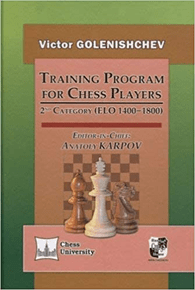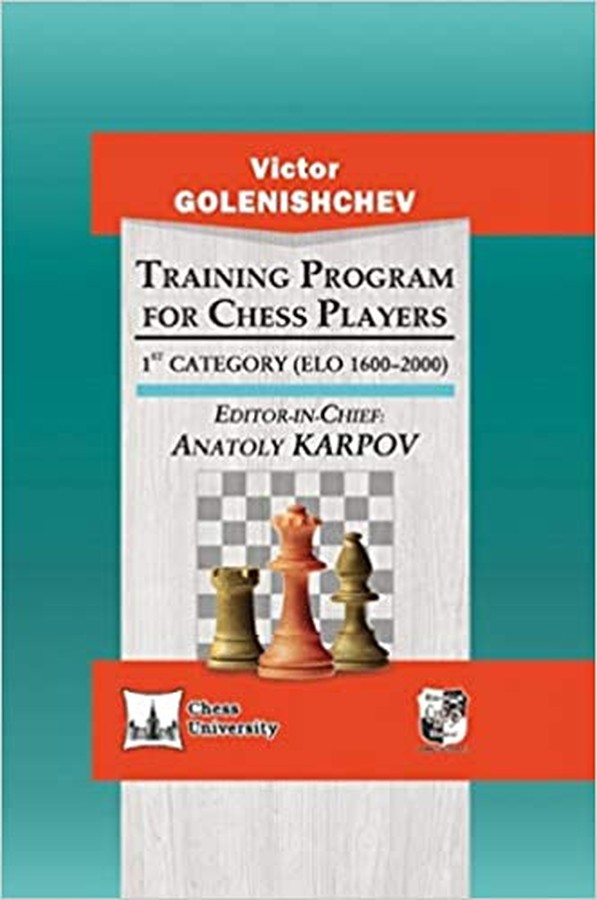| Nivå | C-D |
| Utgivelsesdato | April 2020 |
| Forfatter | |
| Pris | 490 NOK |
Training Program for Chess Players 1st Category
Elo 1600-2000En allround treningsbok oversatt fra russisk, med mye interessant og ganske krevende stoff. Russerne forventer høye ferdigheter. Nivået er etter våre erfaringer gjerne snarere for rating ca 1800 - 2200.
Innhold har mye å gjøre med variantregning, kombinasjoner, sluttspill og midtspill med visse bondestrukturer.
Forlagets egen omtale:
Like other titles in the Training Program for Chess Players series, this volume is both an excellent textbook for independent study and a powerful teaching aid for chess coaches. In the view of many experts, no better work of this kind has ever been written.
The series was designed as a self-contained training program by Victor Golenishchev, a distinguished Soviet chesscoach and Master of Sport. Golenishchev’s programs are still considered critically important and are successfully employed in chess schools. His teaching methods remain popular in Russia and around the world.
Supervised by Editor-in-Chief and former World Chess Champion Anatoly Karpov, this new edition of Golenishchev’s classic work is updated to include important games from recent high-level chess competitions, reflecting modern approaches to the game.
Innholdet:
Guidelines for the topic ‘Training in the technique of calculation’ ........... 9
- 1st lesson. Training in the technique of calculation ................................. 10
- 2nd lesson. Training in the technique of calculation (continuation) ......... 15
- 3rd lesson. Training in the technique of calculation (continuation) ......... 17
- 4th lesson. Training in the technique of calculation (conclusion) ............ 19
Guidelines for the topic ‘Endings’ .......................................................... 21
- 5th lesson. Instructive positions in pawn endings ................................... 22
- 6th lesson. Geometry of the board. ‘Shoulder-charging’ ........................ 27
- 7th lesson. Endings with passed pawns for both sides .............................. 30
- 8th lesson. Endings with passed pawns for both sides (conclusion) .......... 34
- 9th lesson. Pawn breakthrough .............................................................. 38
- 10th lesson. Superior pawn formation .................................................... 41
- 11th lesson. Reserve tempi ..................................................................... 45
- 12th lesson. King activity ....................................................................... 47
- 13th lesson. Transition into a pawn endgame as a method of converting a material or positional advantage ........................ 52
Guidelines for lessons 14, 25 and 36 ....................................................... 56
- 14th lesson. About study composition. Some study ideas in practice ....... 56
- 15th lesson. Instructive positions in rook endings ................................... 62
- 16th lesson. Control of the 7th rank ....................................................... 67
- 17th lesson. Utilising an open file .......................................................... 71
- 18th lesson. Endings with passed pawns ................................................. 76
- 19th lesson. Endings with passed pawns (conclusion) ............................. 82
- 20th lesson. Activity in rook endings ...................................................... 86
- 21st lesson. Exploiting pawn weaknesses ................................................ 91
- 22ndlesson. Some defensive resources ................................................... 94
- 23rd lesson. Conversion of a material advantage .................................... 98
- 24th lesson. Conversion of a positional advantage ................................. 102
- 25th lesson. Some rook studies ............................................................ 105
Guidelines for test exercises ................................................................ 109
- 26th lesson. Combination solving quiz ................................................. 110
- 27th lesson. Combination solving quiz (continuation) ......................... 114
- 28th lesson. Combination solving quiz (conclusion) ............................. 118
- 29th lesson. Blitz quiz ......................................................................... 123
- 30th lesson. Problem solving quiz ........................................................ 127
- 31st lesson. Combination solving quiz ................................................. 133
- 32nd lesson. Combination solving quiz (continuation) .......................... 138
- 33rd lesson. Combination solving quiz (conclusion) ............................. 143
- 34th lesson. Blitz quiz ......................................................................... 148
- 35th lesson. Problem solving quiz ........................................................ 152
- 36th lesson. Study solving quiz ............................................................ 157
Guidelines for the topic ‘Basics of strategy’ ......................................... 161
- 37th lesson. Exploitation of a pawn majority on the queenside ............. 161
- 38th lesson. Exploitation of a pawn majority in the centre or on the kingside ............................................................... 166
- 39th lesson. Fighting against a flank pawn majority .............................. 170
- 40th lesson. Pawn chain ...................................................................... 176
- 41st lesson. Pawn chain (conclusion) ................................................... 181
- 42nd lesson. Qualitative pawn majority ................................................ 186
- 43rd lesson. Restriction of mobility and blockade ................................ 191
- 44th lesson. Restriction of mobility and blockade (conclusion) .............. 197
- 45th lesson. The c3+d4 pawn pair on semi-open files .......................... 200
- 46th lesson. The c3+d4 pawn pair on semi-open files (conclusion) ...... 205
- 47th lesson. Isolated pawn in the centre of the board ............................ 210
- 48th lesson. Isolated pawn in the centre of the board (continuation) ....... 214
- 49th lesson. Isolated pawn in the centre of the board (continuation) ....... 217
- 50th lesson. Isolated pawn in the centre of the board (conclusion) .......... 221
| Innbundet? | Ja |
| Type | Bok |
| Språk | Engelsk |
| Antall sider | 256 |
Se også
-

Training Program for Chess Players 2nd Category Elo 1400-1800
KjøpEn solid og innholdsrik treningsbok fra den sovjetiske sjakkskolen, kjærkomment på engelsk. Gir eksempler fra mesterpartier på mange av de viktigste midtspilltemaene med påfølgende nyttige treningsoppgaver.
- Pris
- 510
- Nivå
- C
- Av
- Utgivelsesdato
- Juli 2018

